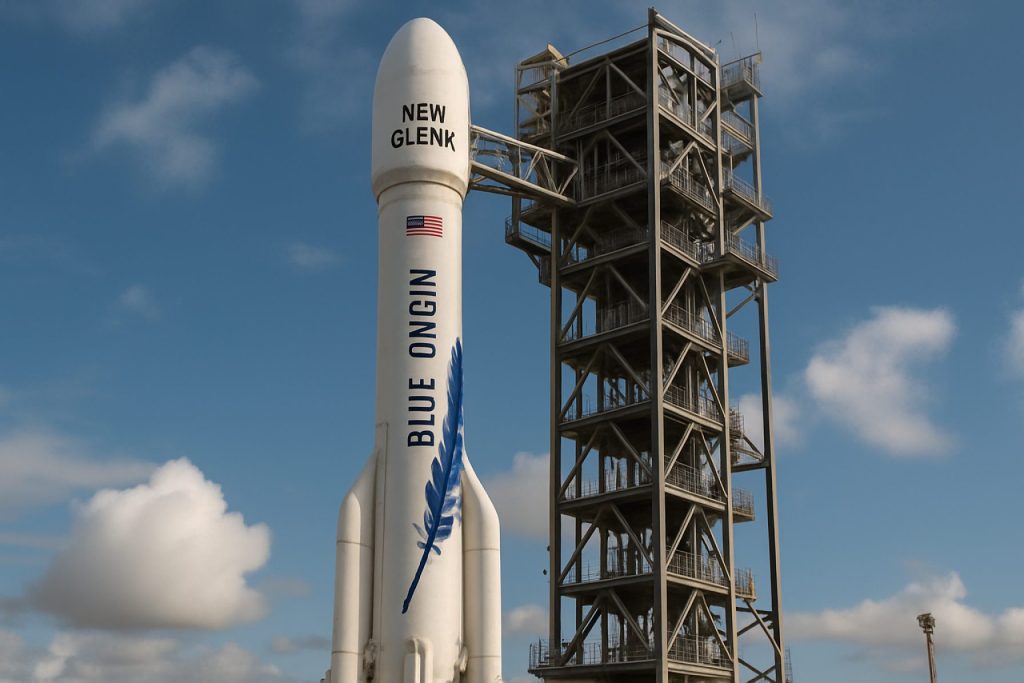
Countdown to History: Blue Origin’s “Never Tell Me The Odds” Booster Aims for Landmark Landing Amidst Space Race Frenzy
Blue Origin gears up for an epic second New Glenn launch in August, seeking first-ever booster landing to rival SpaceX and reshape the space industry.
- 321 feet: Height of the powerful New Glenn rocket
- August 15, 2025: Earliest target date for the highly anticipated next launch
- $150M–$200M: Estimated potential savings per mission if full booster reusability is achieved
- Only SpaceX: Has repeatedly landed multi-stage boosters — so far
—
Excitement crackles along Florida’s Space Coast as Blue Origin, the aerospace titan founded by Jeff Bezos, gears up for a critical – and potentially game-changing – mission. After a dramatic debut in January, the New Glenn rocket, emblazoned with its new booster “Never Tell Me The Odds,” is scheduled to thunder skyward no earlier than August 15, 2025. The world is watching to see: can Blue Origin finally stick the rocket landing and challenge SpaceX’s orbital supremacy?
New Glenn is no mere science experiment. Standing at a towering 321 feet, it dwarfs most rockets and is poised to become the backbone for major payloads, including the hotly anticipated NASA EscaPADE Mars mission and Amazon’s own Project Kuiper internet satellites — a direct competitor to SpaceX’s sprawling Starlink constellation.
All eyes are now on Blue Origin’s next test: can it achieve what only Elon Musk’s SpaceX has done so far — land and reuse a massive orbital booster?
What Happened During January’s New Glenn Launch?
Back in January, anticipation reached a fever pitch as New Glenn roared off Cape Canaveral’s legendary pad 36. The upper stage completed its orbital delivery. But the aftermath was bittersweet: the first-stage booster, nicknamed “So You’re Telling Me There’s a Chance,” missed its shot at landing on the recovery ship, Jacklyn, returning empty to Port Canaveral.
Industry insiders quietly noted that SpaceX’s first landings also came after years of trial and error — giving Blue Origin’s team hope for a breakthrough in its second act.
Why Is This August Launch So Pivotal?
A successful booster recovery could slash launch costs by tens of millions of dollars, shaking up a commercial launch market now dominated by SpaceX. Blue Origin’s CEO, Dave Limp, didn’t mince words as he hyped the mission on social media: this booster isn’t just a hunk of high-tech metal—it’s a moonshot for Blue’s future.
Set to once again target a landing on Jacklyn — the drone ship named after Bezos’ mother — this attempt will test the company’s engineering, precision, and a little luck. The mission is the critical next step towards regular, reusable rocket flights that could open space for more science, business, and even tourism.
How Will This Affect NASA, Amazon, and the Broader Space Race?
An operational, reusable New Glenn rocket gives NASA another powerful ride to Mars — and gives Amazon a dedicated launch fleet for Kuiper, aimed directly at Amazon’s ambitions to beam affordable broadband across the globe. With ULA and SpaceX dominating headlines, Blue Origin’s success here means more competition, more launches, and potentially lower costs for everyone.
And for Florida’s Space Coast, the stakes are equally high — a committed Blue Origin launch cadence brings jobs, investment, and keeps the region buzzing as the world’s space hub.
How to Watch — and What’s Next for Rocket Fans?
Want to witness rocket history? The launch window opens August 15, but keep an eye on weather and final checkouts, as delays are common in the orbital game. Follow updates directly through Blue Origin and Cape Canaveral’s event calendars for live streaming options and public viewing opportunities.
For fans and industry watchers alike, this milestone could reconfigure the commercial space race for years to come. Expect fierce rivalry, innovation, and awe-inspiring moments ahead.
—
Don’t miss the next chapter in the battle for space! Bookmark updates and get ready to witness history August 15.
-
Blue Origin’s New Glenn Launch: What to Watch For
- 📅 August 15: Target launch date
- 🚀 Follow Blue Origin for streaming and updates
- 🛰️ First booster recovery attempt since January
- 🌌 Major payloads: NASA Mars mission, Amazon’s Project Kuiper
- 🏆 Potential to revolutionize commercial orbit launches



